
A. D. Coleman as Hillary Clinton, selfie, 7-24-16
Images and Projections
When weighing the role(s) of images in any election, especially one between contenders for the presidency of the U.S., we need to consider not only the specific visual presences presented by the candidates but also what we might call the electorate’s “mind’s-eye” conceptions: their visions of themselves individually as citizens, their visions of themselves collectively as the citizenry, their visions of America.
Basically, I’m suggesting that there’s a fundamental difference between imagining Donald Trump greeting Vladimir Putin in the Oval Office and visualizing a gifted astrophysicist as our head of state. The former involves a particular, known individual candidate and requires an act of what we might call mental photomontage, in which one chooses and melds existing images from one’s memory bank. The latter involves something more like a Platonic ideal from the world of forms — the idea of a brilliant scientist as our highest elected representative. We can ponder the latter without having a single candidate from any party who fits the description
Let’s call those “projections,” to differentiate them from images, projections having a more amorphous, generalized aspect. To some extent, I’d argue, the public’s projections of this country as one that could have and should have its first African American president, and of themselves as the voters who could and would make that happen — and, four years later, of that not having been a wrong decision — contributed notably to Obama’s two victories.
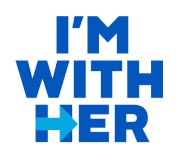 Similarly, their projections of this country as one that could have and should have its first woman president, and of that woman at work in the Oval Office, and of themselves as the voters who could and would make that happen, will play some role — a substantial one, I’d argue — in the coming run for the White House. For any number of reasons, Hillary Clinton may not win the coming election. But the projection of a woman president has grown increasingly strong in recent years; it will actualize itself when the right candidate emerges to flesh it out. I predict that will happen soon.
Similarly, their projections of this country as one that could have and should have its first woman president, and of that woman at work in the Oval Office, and of themselves as the voters who could and would make that happen, will play some role — a substantial one, I’d argue — in the coming run for the White House. For any number of reasons, Hillary Clinton may not win the coming election. But the projection of a woman president has grown increasingly strong in recent years; it will actualize itself when the right candidate emerges to flesh it out. I predict that will happen soon.
I’m With Her
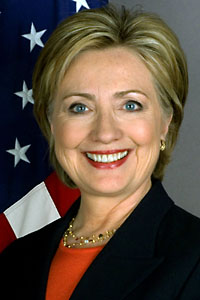
Hillary Rodham Clinton, official portrait
Whatever travails and triumphs have brought her to this moment, Hillary Clinton comes across as a classic career politician who has made her way up the ladder, survived the infighting as well as the slings and arrows, and views the gold ring of the Oval Office as her rightful reward. An unmistakable sense of entitlement radiates from her, the conviction that she has earned this, deserves it — not just on her own merits, but as Bill Clinton’s wife through thick and thin, as a Beltway insider and deal-maker with markers to call in, and as a woman presumably representing her gender’s aspirations for equal treatment on the global stage.
Yet, setting aside her apparatchik aspect, Clinton has stood on the right side of history a number of times, most often in her domestic initiatives and policies. Whatever reservations I have about her — and they’re considerable — pale in comparison to the absolute horror that a Trump victory would bring. That doesn’t make her the lesser of two evils; it makes her a flawed, battle-scarred, toughened yet still teachable mainstream liberal now locked in combat with a sociopathic fascist. I don’t have to think twice about where to mark my ballot.
Into the Wild Blue Yonder

Democratic National Convention logo, 2016
As we headed into the Democratic National Convention, with only a weekend break between its opening and the grand finale of the RNC, we did so with two new developments on the table.
The first consists of a massive document dump by Wikileaks, some of whose contents prove that Bernie Sanders demonstrated not even a whiff of paranoia when he charged the Democratic National Committee with favoring Hillary Clinton and maneuvering against him behind the scenes. The 19,000 leaked emails from seven key DNC figures prove him right on all counts; the system was rigged against him from the start, and the DNC sabotaged his campaign in every way they could, making it all the more remarkable that he got as far as he did.
DNC Chairwoman Debbie Wasserman Schultz has disgraced herself and this committee; she has already resigned under pressure, and the committee members who participated in this scheming should follow her to the exit. After that, the DNC should undergo a thorough restructuring, starting with the formulation of new rules to prevent such chicanery in the future.
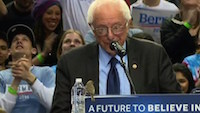
Bernie Sanders with feathered friend, Portland, OR, 3-25-16, screenshot
Bernie Sanders and his supporters deserved much, much better than that. Not even the faintest whiff of entitlement hovers around Sanders. He had to earn every vote and delegate, and, had he won the nomination, would have had to earn the White House. No aura of privilege surrounds him. He has the role of the classic outsider, appearing suddenly in town to set things right. That, incongruously, he has the look and demeanor of someone’s grandfather in some mysterious way adds to his charm, and his effectiveness. His achievement this past year, especially at his age (he’s almost 75, two years older than I am), rebukes all who believe that the old are simply in the way.
Note that I said charm, not charisma. Sanders has no charisma to speak of, so far as I can tell, none of that magnetism which drew people to the Kennedys, Reagan, Clinton, Obama. The fact that he doesn’t need it — that his evident intelligence, decency, integrity, commitment, and honesty suffice in its stead — suggests that all is not yet lost in this nation’s political life.
•
The second piece of news concerns Clinton’s selection of Virginia Senator Tim Kaine as her running mate. I watched the July 23 Miami rally at which Clinton announced her choice of Kaine and introduced him in that role, listening to both their speeches in their entirety.
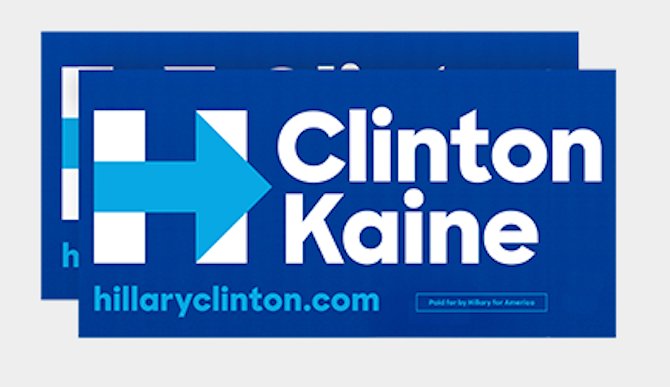 I have to say that I consider the decision to go with Kaine a smart one. Not only is Kaine, in Clinton’s words, “everything that Donald Trump and Mike Pence are not,” he’s also many things that Clinton herself is not — at least when she’s on stage. Affable, easygoing, informal, comfortable in his own skin, Kaine balances her very nicely in areas that we can consider intangible — presence, affect, immediate likeability.
I have to say that I consider the decision to go with Kaine a smart one. Not only is Kaine, in Clinton’s words, “everything that Donald Trump and Mike Pence are not,” he’s also many things that Clinton herself is not — at least when she’s on stage. Affable, easygoing, informal, comfortable in his own skin, Kaine balances her very nicely in areas that we can consider intangible — presence, affect, immediate likeability.
The speeches given by Cory Booker and Elizabeth Warren on the first day of the convention showed why Clinton had them both on her short list for the veep slot. But Clinton didn’t need to validate her feminist creds by putting Warren on the ticket, nor her creds with African Americans by picking Booker. Like Joe Biden before him, Kaine doesn’t aspire to higher office; this is likely as far as he goes, and further than he ever expected.
Kaine’s a happy second-in-command, appreciative of the opportunity, and he radiates that devoted sidekick attitude. His enthusiastic support of Clinton gives the immediate impression of a solid union. Coming on the heels of the ugliness of Donald Trump’s reluctant choice of Mike Pence — not to mention Pence’s own dour persona — the creation of the Clinton-Kaine team seems sensibly mainstream, and thus reassuring to any disillusioned centrist Republicans and independents.
•
As long as I’m on the subject of Trump, I should mention the very last image of the Republic Party’s convention that he delivered to us — his first post-convention tweet, summarizing his view of the events of those days. In it he points to the most important facts about his speech accepting the nomination: that it lasted 75 minutes and drew 24 minutes of applause, so that the applause constituted 33 percent of the total time consumed. (In point of fact, it’s 22 percent.)
This, in Trump’s mind, the world needs to know. Can you say “textbook case of narcissistic personality disorder,” boys and girls?
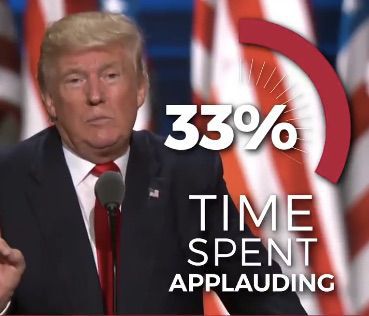
Donald Trump congratulates himself on his RNC acceptance speech, Twitter, July 23, 2016
Changing the Channel
I turned to the Democratic National Convention in Philadelphia with an enormous sense of relief. It felt like moving from a context of schoolyard vulgarity to a space for mature, intelligent dialogue. Even the bruising debacle over the email scandal and the disenfranchisement of Sanders got handled, if not without rancor, at least without demoralizing tantrums.
 To the contrary: On behalf of his commitments and his supporters, Sanders carefully milked the situation for everything he could get — not only in re major planks in the party platform, the ouster of Wasserman, and the public apology from the Democratic National Committee for the email revelations, but structural reform of the DNC, an influential spot for him in the party structure, and the ear of Clinton henceforth (and possibly, if she wins the election, a role in her administration).
To the contrary: On behalf of his commitments and his supporters, Sanders carefully milked the situation for everything he could get — not only in re major planks in the party platform, the ouster of Wasserman, and the public apology from the Democratic National Committee for the email revelations, but structural reform of the DNC, an influential spot for him in the party structure, and the ear of Clinton henceforth (and possibly, if she wins the election, a role in her administration).
In one year, Sanders and his followers succeeded in driving the Democratic Party out of the center. And if that does not make the Dems truly leftist, it moves them closer to that than they have been since the middle 1960s. The way to make them stay there and even move further left, he understands, is to forge a coalition between the mainstream Dems and the Sanders faction. It’s a sign of his political savvy that Sanders accomplished that merger, and it speaks well of the forces he unleashed that the majority of them have seen the wisdom in that.
Musical Interlude
Why, during a break in the proceedings on Monday, did we hear the sound system at the DNC playing Tommy Tutone’s 1982 hit “Jenny (867-5309)”? It’s a rockin’ song, to be sure, but — describing as it does a nerd’s anxiety about calling a girl whose phone number he found scribbled on a wall — it hardly seemed appropriate for the occasion.
•
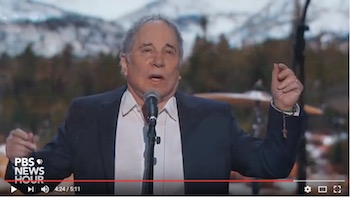
Paul Simon, DNC, 7-25-16, screenshot
As a long-time Paul Simon fan who has enjoyed his music from the very first Simon & Garfunkel album through his latest release, Stranger to Stranger, I found his Monday night appearance at the convention unnerving. Not only did he have the look and mannerisms of the disheveled lounge singer Bill Murray used to parody, wearing something resembling a crucifix dangling from his left wrist, but he picked the wrong song to sing.
Not that “Bridge Over Troubled Waters” was the wrong song for this occasion, with its message of healing and triumph over adversity. But Paul Simon — at least the Simon of today — was not the singer for it. He never had the range that enabled Art Garfunkel’s soaring version, and today, turning 75 come October, his pipes just aren’t up to it. Instead, we got a strained, off-key version that I’d consider the worst live performance of his on record.
The crowd, on its feet and swaying, didn’t seem to care. But better by far, I think, to have chosen something on which he could have shone. Had I been his A&R man, I’d have proposed two options. The first? “Graceland,” with its magical opening line and vision of the melting pot:
The Mississippi Delta
Was shining like a National guitar
I am following the river
Down the highway
Through the cradle of the Civil War
I’m going to Graceland
Graceland
In Memphis, Tennessee
I’m going to Graceland
Poorboys and pilgrims with families
And we are going to Graceland
My traveling companion is nine years old
He is the child of my first marriage
But I’ve reason to believe
We all will be received
In Graceland
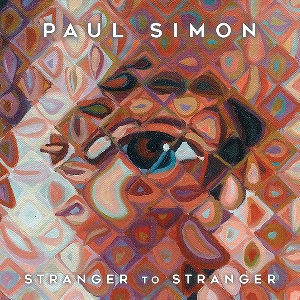
Paul Simon, “Stranger to Stranger” (2016), cover
And the second, from the new album, would have been “Wristband,” whose last verse expands from the initial narrative of a small-scale confrontation with authority (in the person of a doorman at a music venue) to something much, much larger:
The riots started slowly with the homeless and the lowly
Then they spread into the heartland towns that never get a wristband
Kids that can’t afford the cool brand whose anger is a short-hand
For you’ll never get a wristband and if you don’t have a wristband then you can’t get through the door
No you can’t get through the door
No you can’t get through the door
Say you can’t get through the door, no
•
I saw two enormously powerful images on the first day of the DNC. To begin with, and then throughout the program, it was simply the image on my screen as the TV cameras roamed the convention hall. They didn’t have to scan a sea of white faces in search of someone of color, as they did in Cleveland. Wherever they stopped, they showed the United States as I recognize it, the “beautiful mosaic” of this nation. The contrast between that reality and the #GOPSoWhite demographic of the Republic Party convention last week really tells me everything I need to know about where I belong and which side I’m on.
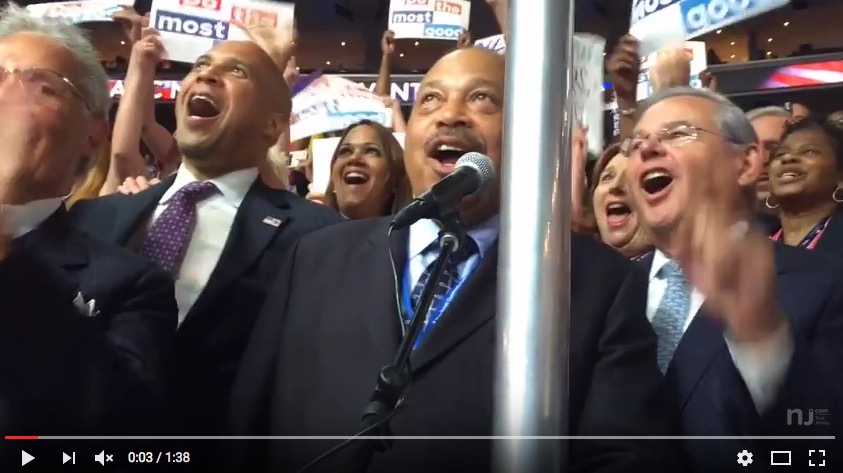
New Jersey delegation casting its votes, DNC, 7-26-16, screenshot
The second image, no less stunning if in a different way, happened during the astonishing speech delivered by Michelle Obama on Monday night. Immediately hailed as one of the great DNC speeches of all time, brilliantly thought through and superbly delivered, it did everything it needed to do: celebrate the Obama administration’s successes, eviscerate Trump, put the FLOTUS stamp of approval on Clinton, and show the world what a proud, beautiful, intelligent black woman can do in politics.
But Michelle Obama didn’t stop there. She chose, with great dignity, to speak about black history, and specifically to highlight one telling, little-known, and rarely mentioned historical fact:
“… [T]he story of this country, the story that has brought me to this stage tonight, [is] the story of generations of people who felt the lash of bondage, the shame of servitude, the sting of segregation, but who kept on striving and hoping and doing what needed to be done so that today, I wake up every morning in a house that was built by slaves — and I watch my daughters — two beautiful, intelligent, black young women — playing with their dogs on the White House lawn. And because of Hillary Clinton, my daughters — and all our sons and daughters — now take for granted that a woman can be president of the United States.”
This was Michelle Obama’s historical moment, searing itself into the national consciousness with the same fire that blazed in Beyoncé’s Super Bowl “Formation” performance. Carefully calibrated for the occasion, surely, but just as potent in its own way.
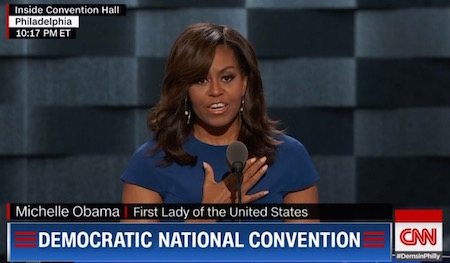
Michelle Obama, DNC speech, 7-25-16, screenshot
•
(For an index of links to all posts in this series, click here.)
•
 Special offer: If you want me to either continue pursuing a particular subject or give you a break and (for one post) write on a topic — my choice — other than the current main story, make a donation of $50 via the PayPal widget below, indicating your preference in a note accompanying your donation. I’ll credit you as that new post’s sponsor, and link to a website of your choosing. Include a note with your snail-mail address (or email it to me separately) for a free signed copy of my 1995 book Critical Focus!
Special offer: If you want me to either continue pursuing a particular subject or give you a break and (for one post) write on a topic — my choice — other than the current main story, make a donation of $50 via the PayPal widget below, indicating your preference in a note accompanying your donation. I’ll credit you as that new post’s sponsor, and link to a website of your choosing. Include a note with your snail-mail address (or email it to me separately) for a free signed copy of my 1995 book Critical Focus!
Election 2016: Image World (11)
A. D. Coleman as Hillary Clinton, selfie, 7-24-16
Images and Projections
When weighing the role(s) of images in any election, especially one between contenders for the presidency of the U.S., we need to consider not only the specific visual presences presented by the candidates but also what we might call the electorate’s “mind’s-eye” conceptions: their visions of themselves individually as citizens, their visions of themselves collectively as the citizenry, their visions of America.
Basically, I’m suggesting that there’s a fundamental difference between imagining Donald Trump greeting Vladimir Putin in the Oval Office and visualizing a gifted astrophysicist as our head of state. The former involves a particular, known individual candidate and requires an act of what we might call mental photomontage, in which one chooses and melds existing images from one’s memory bank. The latter involves something more like a Platonic ideal from the world of forms — the idea of a brilliant scientist as our highest elected representative. We can ponder the latter without having a single candidate from any party who fits the description
Let’s call those “projections,” to differentiate them from images, projections having a more amorphous, generalized aspect. To some extent, I’d argue, the public’s projections of this country as one that could have and should have its first African American president, and of themselves as the voters who could and would make that happen — and, four years later, of that not having been a wrong decision — contributed notably to Obama’s two victories.
I’m With Her
Hillary Rodham Clinton, official portrait
Whatever travails and triumphs have brought her to this moment, Hillary Clinton comes across as a classic career politician who has made her way up the ladder, survived the infighting as well as the slings and arrows, and views the gold ring of the Oval Office as her rightful reward. An unmistakable sense of entitlement radiates from her, the conviction that she has earned this, deserves it — not just on her own merits, but as Bill Clinton’s wife through thick and thin, as a Beltway insider and deal-maker with markers to call in, and as a woman presumably representing her gender’s aspirations for equal treatment on the global stage.
Yet, setting aside her apparatchik aspect, Clinton has stood on the right side of history a number of times, most often in her domestic initiatives and policies. Whatever reservations I have about her — and they’re considerable — pale in comparison to the absolute horror that a Trump victory would bring. That doesn’t make her the lesser of two evils; it makes her a flawed, battle-scarred, toughened yet still teachable mainstream liberal now locked in combat with a sociopathic fascist. I don’t have to think twice about where to mark my ballot.
Into the Wild Blue Yonder
Democratic National Convention logo, 2016
As we headed into the Democratic National Convention, with only a weekend break between its opening and the grand finale of the RNC, we did so with two new developments on the table.
The first consists of a massive document dump by Wikileaks, some of whose contents prove that Bernie Sanders demonstrated not even a whiff of paranoia when he charged the Democratic National Committee with favoring Hillary Clinton and maneuvering against him behind the scenes. The 19,000 leaked emails from seven key DNC figures prove him right on all counts; the system was rigged against him from the start, and the DNC sabotaged his campaign in every way they could, making it all the more remarkable that he got as far as he did.
DNC Chairwoman Debbie Wasserman Schultz has disgraced herself and this committee; she has already resigned under pressure, and the committee members who participated in this scheming should follow her to the exit. After that, the DNC should undergo a thorough restructuring, starting with the formulation of new rules to prevent such chicanery in the future.
Bernie Sanders with feathered friend, Portland, OR, 3-25-16, screenshot
Bernie Sanders and his supporters deserved much, much better than that. Not even the faintest whiff of entitlement hovers around Sanders. He had to earn every vote and delegate, and, had he won the nomination, would have had to earn the White House. No aura of privilege surrounds him. He has the role of the classic outsider, appearing suddenly in town to set things right. That, incongruously, he has the look and demeanor of someone’s grandfather in some mysterious way adds to his charm, and his effectiveness. His achievement this past year, especially at his age (he’s almost 75, two years older than I am), rebukes all who believe that the old are simply in the way.
Note that I said charm, not charisma. Sanders has no charisma to speak of, so far as I can tell, none of that magnetism which drew people to the Kennedys, Reagan, Clinton, Obama. The fact that he doesn’t need it — that his evident intelligence, decency, integrity, commitment, and honesty suffice in its stead — suggests that all is not yet lost in this nation’s political life.
•
The second piece of news concerns Clinton’s selection of Virginia Senator Tim Kaine as her running mate. I watched the July 23 Miami rally at which Clinton announced her choice of Kaine and introduced him in that role, listening to both their speeches in their entirety.
The speeches given by Cory Booker and Elizabeth Warren on the first day of the convention showed why Clinton had them both on her short list for the veep slot. But Clinton didn’t need to validate her feminist creds by putting Warren on the ticket, nor her creds with African Americans by picking Booker. Like Joe Biden before him, Kaine doesn’t aspire to higher office; this is likely as far as he goes, and further than he ever expected.
Kaine’s a happy second-in-command, appreciative of the opportunity, and he radiates that devoted sidekick attitude. His enthusiastic support of Clinton gives the immediate impression of a solid union. Coming on the heels of the ugliness of Donald Trump’s reluctant choice of Mike Pence — not to mention Pence’s own dour persona — the creation of the Clinton-Kaine team seems sensibly mainstream, and thus reassuring to any disillusioned centrist Republicans and independents.
•
As long as I’m on the subject of Trump, I should mention the very last image of the Republic Party’s convention that he delivered to us — his first post-convention tweet, summarizing his view of the events of those days. In it he points to the most important facts about his speech accepting the nomination: that it lasted 75 minutes and drew 24 minutes of applause, so that the applause constituted 33 percent of the total time consumed. (In point of fact, it’s 22 percent.)
This, in Trump’s mind, the world needs to know. Can you say “textbook case of narcissistic personality disorder,” boys and girls?
Donald Trump congratulates himself on his RNC acceptance speech, Twitter, July 23, 2016
Changing the Channel
I turned to the Democratic National Convention in Philadelphia with an enormous sense of relief. It felt like moving from a context of schoolyard vulgarity to a space for mature, intelligent dialogue. Even the bruising debacle over the email scandal and the disenfranchisement of Sanders got handled, if not without rancor, at least without demoralizing tantrums.
In one year, Sanders and his followers succeeded in driving the Democratic Party out of the center. And if that does not make the Dems truly leftist, it moves them closer to that than they have been since the middle 1960s. The way to make them stay there and even move further left, he understands, is to forge a coalition between the mainstream Dems and the Sanders faction. It’s a sign of his political savvy that Sanders accomplished that merger, and it speaks well of the forces he unleashed that the majority of them have seen the wisdom in that.
Musical Interlude
Why, during a break in the proceedings on Monday, did we hear the sound system at the DNC playing Tommy Tutone’s 1982 hit “Jenny (867-5309)”? It’s a rockin’ song, to be sure, but — describing as it does a nerd’s anxiety about calling a girl whose phone number he found scribbled on a wall — it hardly seemed appropriate for the occasion.
•
Paul Simon, DNC, 7-25-16, screenshot
As a long-time Paul Simon fan who has enjoyed his music from the very first Simon & Garfunkel album through his latest release, Stranger to Stranger, I found his Monday night appearance at the convention unnerving. Not only did he have the look and mannerisms of the disheveled lounge singer Bill Murray used to parody, wearing something resembling a crucifix dangling from his left wrist, but he picked the wrong song to sing.
Not that “Bridge Over Troubled Waters” was the wrong song for this occasion, with its message of healing and triumph over adversity. But Paul Simon — at least the Simon of today — was not the singer for it. He never had the range that enabled Art Garfunkel’s soaring version, and today, turning 75 come October, his pipes just aren’t up to it. Instead, we got a strained, off-key version that I’d consider the worst live performance of his on record.
The crowd, on its feet and swaying, didn’t seem to care. But better by far, I think, to have chosen something on which he could have shone. Had I been his A&R man, I’d have proposed two options. The first? “Graceland,” with its magical opening line and vision of the melting pot:
The Mississippi Delta
Was shining like a National guitar
I am following the river
Down the highway
Through the cradle of the Civil War
I’m going to Graceland
Graceland
In Memphis, Tennessee
I’m going to Graceland
Poorboys and pilgrims with families
And we are going to Graceland
My traveling companion is nine years old
He is the child of my first marriage
But I’ve reason to believe
We all will be received
In Graceland
Paul Simon, “Stranger to Stranger” (2016), cover
And the second, from the new album, would have been “Wristband,” whose last verse expands from the initial narrative of a small-scale confrontation with authority (in the person of a doorman at a music venue) to something much, much larger:
The riots started slowly with the homeless and the lowly
Then they spread into the heartland towns that never get a wristband
Kids that can’t afford the cool brand whose anger is a short-hand
For you’ll never get a wristband and if you don’t have a wristband then you can’t get through the door
No you can’t get through the door
No you can’t get through the door
Say you can’t get through the door, no
•
I saw two enormously powerful images on the first day of the DNC. To begin with, and then throughout the program, it was simply the image on my screen as the TV cameras roamed the convention hall. They didn’t have to scan a sea of white faces in search of someone of color, as they did in Cleveland. Wherever they stopped, they showed the United States as I recognize it, the “beautiful mosaic” of this nation. The contrast between that reality and the #GOPSoWhite demographic of the Republic Party convention last week really tells me everything I need to know about where I belong and which side I’m on.
New Jersey delegation casting its votes, DNC, 7-26-16, screenshot
The second image, no less stunning if in a different way, happened during the astonishing speech delivered by Michelle Obama on Monday night. Immediately hailed as one of the great DNC speeches of all time, brilliantly thought through and superbly delivered, it did everything it needed to do: celebrate the Obama administration’s successes, eviscerate Trump, put the FLOTUS stamp of approval on Clinton, and show the world what a proud, beautiful, intelligent black woman can do in politics.
But Michelle Obama didn’t stop there. She chose, with great dignity, to speak about black history, and specifically to highlight one telling, little-known, and rarely mentioned historical fact:
“… [T]he story of this country, the story that has brought me to this stage tonight, [is] the story of generations of people who felt the lash of bondage, the shame of servitude, the sting of segregation, but who kept on striving and hoping and doing what needed to be done so that today, I wake up every morning in a house that was built by slaves — and I watch my daughters — two beautiful, intelligent, black young women — playing with their dogs on the White House lawn. And because of Hillary Clinton, my daughters — and all our sons and daughters — now take for granted that a woman can be president of the United States.”
This was Michelle Obama’s historical moment, searing itself into the national consciousness with the same fire that blazed in Beyoncé’s Super Bowl “Formation” performance. Carefully calibrated for the occasion, surely, but just as potent in its own way.
Michelle Obama, DNC speech, 7-25-16, screenshot
•
(For an index of links to all posts in this series, click here.)
•